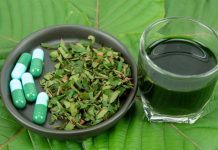Kratom’s intake in the form of powder is perhaps the most widely recognized and executed method of Kratom consumption. This trend has been changing in recent years because of the introduction of Kratom capsules into the scene.
With more and more people switching to them as an easier alternative, capsules have earned an important position not only on market shelves but also in the hearts of people.
This article will deal with Kratom dosage in both, powder and capsule form, and will include a detailed about Kratom dosage guideline and various other tips to ensure a safe user experience.
What is Kratom and is it FDA Approved?
 Kratom, scientifically known as Mitragyna speciosa, is an evergreen tree native to the tropics of Southeast Asia. While people have been using Kratom plants and leaves traditionally, for thousands of years, the substance has only recently found popularity as a medicinal herb.
Kratom, scientifically known as Mitragyna speciosa, is an evergreen tree native to the tropics of Southeast Asia. While people have been using Kratom plants and leaves traditionally, for thousands of years, the substance has only recently found popularity as a medicinal herb.
This increasing fame of Kratom is not only because of its numerous therapeutic effects but also because of its use as a milder substitute for recreational drugs.
Latest research into the properties of Kratom suggested that although the plant may be considered potentially harmless, it can pose certain health risks if overdosed. Health authorities such as the FDA, are concerned about the increasing use of the plant, and have, therefore, taken certain steps to regulate its consumption and distribution.
Not only this, many countries, including Thailand, Finland, Malaysia, Australia, and Denmark, have added Kratom into their lists of controlled substances. The authorities state that the greatest health threat with regular Kratom usage is dependency and tolerance buildup.
They also state that Kratom, being opiate-like can cause severe withdrawal symptoms, which may include mood alterations, weight loss, anorexia, diarrhea, muscle aches and spasms, fever, hot flushes, and insomnia.
While all these fears are genuine, they can be easily avoided if users follow appropriate instructions and stick to Kratom dosage guidelines. It will help them have a safer journey.
The Correct Kratom Dosage: Points To Note Down
- If you’re a beginner, start with a low Kratom dose and gradually increase it until you find your ‘sweet-spot.’
- Take Kratom on an empty stomach. This will make sure you get faster and more potent results.
- Drinks lots of water as Kratom may tend to have a dehydrating effect on your body.
- Before taking another shot at Kratom, wait up to 30-40 minutes for the results to kick in.
- Remember all strains deliver different effects and therefore, require different dosages. Don’t stick to the same dosage if you’re switching between strains.
- Keep a log for dosages and different strains.
How to Accurately Dose/Measure Kratom Powder?
 Knowing how much Kratom powder you’re ingesting is one of the key requirements for a safe Kratom experience.
Knowing how much Kratom powder you’re ingesting is one of the key requirements for a safe Kratom experience.
Many users show carelessness in this regard and end up facing unpleasant inconveniences. To accurately measure Kratom powder, users are always strongly recommended to use a digital scale.
These scales are not only easy to use but are also available at all leading Kratom vendors at astonishingly adequate prices.
These scales are much preferred because Kratom powder varies in texture and fineness from brand to brand, and therefore, relying on volumetric measurements (using tablespoons/teaspoons) tends to be highly inconsistent and dangerous.
What is an Appropriate Kratom Dosage in Powder?
Kratom powder dosage varies greatly from person to person, depending upon various external and internal factors such as diet, food and water intake, weight, height, activity level, metabolic rate, and individual biochemistry.
While some people may tend to achieve the desired effects at low dosages, others might have to experiment with the upper ranges. This, however, doesn’t change the fact that each should start from a very small dose. An amount of 2g can deliver subtle effects of Kratom and considered as the threshold dose.
However, if the individual doesn’t feel any results within the next 30-40 minutes, they may increase the dosage by 1g. It is important to note that your can increase the dosage only very slightly, and discover the ‘sweet spot’ through a series of experiments.
This will ensure that you achieve the desired effects with a minimum dosage, which will not only save your money but also help keep your tolerance low. Below is a beginner’s guide about Kratom powder dosage;
-
1-2g: Threshold dose
This is the minimum Kratom starting dose in powder for beginners that can deliver subtle stimulating and uplifting effects.
-
2-5g: Light to Moderate dose
At this dosage, the user usually feels the full spectrum effects of the plant. This dosage is for regular users as it not only unravels the stimulating properties of Kratom powder but also delivers analgesic and sedative effects.
-
5-9g: Kratom Strong dose
At this dosage, the effects of Kratom are mostly sedating. This dosage is mostly for people who suffer from chronic pain, anxiety, and insomnia and are looking for strong analgesic and sedative effects. Since this dosage falls in the upper ranges, continued use is not recommended. It will not only build tolerance but also cause nausea or vomiting in some cases.
-
9g and above: Very high dose
Taking more than 9g of Kratom means you’re overdosing, and need to cut down on your intake immediately. Avoid this Kratom dosage as it can bring about all the unnecessary inconveniences that are associated with the abuse of the drug.
How to Calculate Kratom Dosage in Capsules Form?
Kratom capsules are the trendiest products nowadays in the Kratom industry. They’ve gained a lot of praise for their easy to use ingestion, handling, and potency. Kratom capsule options at a great price are available at Golden Monk especially for being AKA-approved, GMP-certified, and with transparent COAs.
In addition to this, these capsules are spill free, completely tasteless, and easily taken with or without the help of any drink due to which they are achieving a lot of popularity. Perhaps the best thing about capsules is that they already have a measured amount of powder in them, which makes the task of dosing even easier.
The Kratom capsules may come in sizes that range from 000 to size 04, the former being the largest and the latter being the smallest. Kratom vendors have, however, set size 00, which holds about 546 mg or 0.546 g of the powder inside, as the standard size for Kratom capsules.
This means that if you typically take around 2g of Kratom powder, then four, 500mg Kratom capsules will be able to substitute for that. If let’s say, you take 3g of Kratom powder; then six capsules will have to do the job. That’s how easy it is, with no worries about finding scales, measurements or fears of overdosing.
What is the Best Kratom Dosage in Capsules?
Capsules have Kratom powder with relatively higher potencies and therefore tend to deliver the desired effects in the lower dose range. Since capsules are gelatin coated, they may take more time for digestion, and therefore, show delayed effects. For this reason, it is best to wait a further 10-15 minutes while experimenting with capsule dosage. Below is a dosage guideline for Kratom capsules;
-
2-4 Capsules: Low Dose
This dosage substitutes for about 1-2g of Kratom powder, mild energizing and stimulating dosage. Since this dose is also slightly uplifting, it is usually best for people who want to perform light duties or chores efficiently.
-
4-8 Capsules: Medium Dose
A medium Kratom dosage in capsule form accounts for about 2-4g of highly potent Kratom powder. This dose can deliver slight sedation, analgesia, as well as significant mood improvement, energy, and stimulation.
It also provides Nootropic assistance and stress relief. This dosage is for most regular users who state that it delivers a broad range of effects which are very beneficial on a daily basis.
-
8-10 Capsules: Strong Dose
This is considered a high dose, with effects that are mostly sedative. This dosage delivers strong analgesic, sedative as well as anxiolytic effects. It is only recommended for people who suffer from severe pain and mood disorders.
-
10+ Capsules: Very Strong Dose
This dosage tends to provide very strong effects. It is used for opiate withdrawal suppression and to achieve a state of euphoria. It also acts as a very strong painkiller, a sleeping aid, as well as a strong sedative.
What Should You Know Before Taking Kratom?
Kratom (Mitragyna speciosa) has a long history of use that dates back hundreds of years. The plant, despite its traditional use in medicine, has only recently caught the attention of the medicinal industry.
While Kratom has quickly gained popularity across the world, there is still limited scientific data to authenticate the numerous health benefits of the plant. It is because of this reason that Kratom remains a controversial substance in various parts of the world, with many people remaining skeptical about it.
Types of Kratom
Before starting your first Kratom dosage, we advise that you have a thorough knowledge of what you’re getting into. Taking Kratom strains randomly because ‘someone’ said it was a great herb could become a great inconvenience.
Kratom DOES NOT deliver the same effects for every individual. The attributes of the plant are not limited to what we commonly observe and hence can bring about the opposite results, contrary to the ones we desire.
While many inexperienced people will call it the unpredictably and inconsistency of the plant, the more aware will associate this property to the availability of the different strains of the plant.
The plant comes in more than a dozen varieties, depending upon environmental conditions, the area of growth, the color of the vein, the blend of alkaloids and breeding techniques.
Following are the most commonly known Kratom strains;
- Red-veined Kratom
- White-veined Kratom
- Green-veined Kratom
- Yellow/Golden Kratom
- Thai Kratom
- Indo Kratom
- Malay Kratom
- Borneo Kratom
- Bali Kratom
- Kali Kratom
- Maeng Da Kratom
Effects of Kratom
As previously stated, Kratom has the characteristic of delivering different results, which are not only strain dependent but are also affected by the amount of intake.
Typically, though, Kratom can be used as an analgesic, anxiolytic, aphrodisiac and anti-inflammatory substance. It is believed to relieve conditions of chronic pain, anxiety, depression, stress, edginess, nervousness, muscle spasms, cramps, seizures, malaria, cancer, and opioid withdrawal symptoms.
Also, at low doses, the plant is believed to deliver stimulating effects, but increasing the dosage highlights the sedating properties of the plant.
In addition to this, the Red strains are considered relatively sedating; the Whites are considered highly energizing and stimulating while the greens are believed to provide common effects.
How to Take Kratom?
You can take Kratom is in many ways. People usually take it by the toss and wash method. In this method, you have to take the dose of Kratom in powder form, place it in your mouth and drink a gulp of water or some juice.
Allow it to stay in your mouth for a while before swallowing it. This method can bring about effects within 15-20 minutes. To aid digestion of Kratom, you can take it with citrus juices especially cranberry juice.
You can take Kratom capsules too. You can buy them (that are relatively expensive than the powder) or make them at home. This is a very convenient method and allows one to take pre-measured doses of Kratom, so there is no requirement of preparation.
However, the additional encapsulation around Kratom can delay the digestion. Thus, this method gives effects about 20-30 minutes after ingestion.
People also take Kratom blends, tinctures, and extracts. These are relatively stronger as these are Kratom concentrates. We must recommend you not to take the concentrates on a daily basis as you can develop dependence as well as tolerance.
Kratom Dosage for Different Strains
Since we know Kratom shows different properties with different strains, it would be insane and irresponsible of users to stick to the same dosage while switching between strains.
Let’s understand that every particular strain has its dosage guidelines, which should require research before taking the plant.
Users should realize that there are strains such as the Red-veined Kratom, Maeng Da Kratom, Bali Kratom, and Thai Kratom, are highly potent strains.
Taking high doses of these strains can result in adverse effects. Some strains on the other hand, such as Borneo Kratom and the Green strains, could be dosed in the higher ranges as they aren’t relatively potent and prone to side-effects.
You can use the general dosage guideline below before taking Kratom;
- Threshold Dosage: 1-2g
- Mild Dosage: 2-3g
- Moderate Dosage: 3-6g
- High Dosage: 6-9g
- Very High Kratom Dosage (Not recommended): 9g or above.
This dosage guideline is for those users who are beginners and have utterly no idea where to start or how to start. Users should start from the lowest possible dose, perhaps 1g, as this is the threshold dosage that usually delivers subtle effects of the plant.
To find the sweet spot, where one gets maximum effects, you can increase the dosage slightly. Users not to take high dosages as it can lead to an increase in the risks of adverse effects.
Kratom Drug Screening Tests
The next big question that arises regarding the use of Kratom is that whether the plant shows up on drug and body screening tests. Many people who avoid consuming this ‘opiate-like’ plant fear that it might show up on drug tests.
This, however, is a misplaced concept, as mitragynine, which is the main component of Kratom, and has opiate-like properties, does not show up on any drug tests. This is because Kratom is legal in most parts of the world, and there is as yet no test that reveals the use of Kratom.
ven a NIDA5 and the extended 10-panel urine test will show negative if Kratom is all that a person has used. Tests that are specifically tailored to reveal mitragynine and its metabolites can detect Kratom.
Side-effects of Kratom
Being aware of a substance’s side-effects before intake is usually very beneficial, as any unwanted effects that might show won’t get the user off-guard.
In the case of Kratom, which is a potentially harmless medicinal herb, negative results are very rare and show up usually because of the user’s carelessness.
Although not that common, the side-effects of Kratom use are; Loss of appetite, nausea, feeling like vomiting, Itching, sweating excessively, dry mouth and dehydration, constipation, diarrhea, increased heartbeat and drowsiness.
In worst case scenarios, regular Kratom dosage may also lead to dependency, tolerance and withdrawal symptoms on quitting. Kratom use is also unsafe for pregnant women and children.
[expand title=”%(%strong%)%See References:%(%/strong%)%” id=”r2d2wiki”]
- Swogger MT, Hart E, Erowid F, Erowid E, Trabold N, Yee K, Parkhurst KA, Priddy BM, Walsh Z. Experiences of kratom users: a qualitative analysis. Journal of Psychoactive Drugs. 2015 Oct 20;47(5):360-7.
- Prozialeck WC, Jivan JK, Andurkar SV. Pharmacology of kratom: an emerging botanical agent with stimulant, analgesic and opioid-like effects. The Journal of the American Osteopathic Association. 2012 Dec 1;112(12):792-9.
- Singh D, Narayanan S, Vicknasingam B. Traditional and non-traditional uses of Mitragynine (Kratom): a survey of the literature. Brain research bulletin. 2016 Sep 1;126:41-6.
- Rosenbaum CD, Carreiro SP, Babu KM. Here today, gone tomorrow and back again? A review of herbal marijuana alternatives (K2, Spice), synthetic cathinones (bath salts), kratom, Salvia divinorum, methoxetamine, and piperazines. Journal of medical toxicology. 2012 Mar 1;8(1):15-32.
- Prozialeck WC. Update on the pharmacology and legal status of Kratom. J Am Osteopath Assoc. 2016 Dec 1;116(12):802-9.
- Stolt AC, Schröder H, Neurath H, Grecksch G, Höllt V, Meyer MR, Maurer HH, Ziebolz N, Havemann-Reinecke U, Becker A. Behavioral and neurochemical characterization of kratom (Mitragynaspeciosa) extract. Psychopharmacology. 2014 Jan 1;231(1):13-25.
- Gilron I, Bailey JM, Tu D, Holden RR, Weaver DF, Houlden RL. Morphine, gabapentin, or their combination for neuropathic pain. New England Journal of Medicine. 2005 Mar 31;352(13):1324-34.
- Warner ML, Kaufman NC, Grundmann O. The pharmacology and toxicology of kratom: from traditional herb to drug of abuse. International journal of legal medicine. 2016 Jan 1;130(1):127-38.
- Ismail I, Wahab S, Sidi H, Das S, Lin LJ, Razali R. Kratom and Future Treatment for the Opioids Addiction and Chronic Pain: Periculo Beneficium?. Current drug targets. 2017 Apr.
[/expand]









